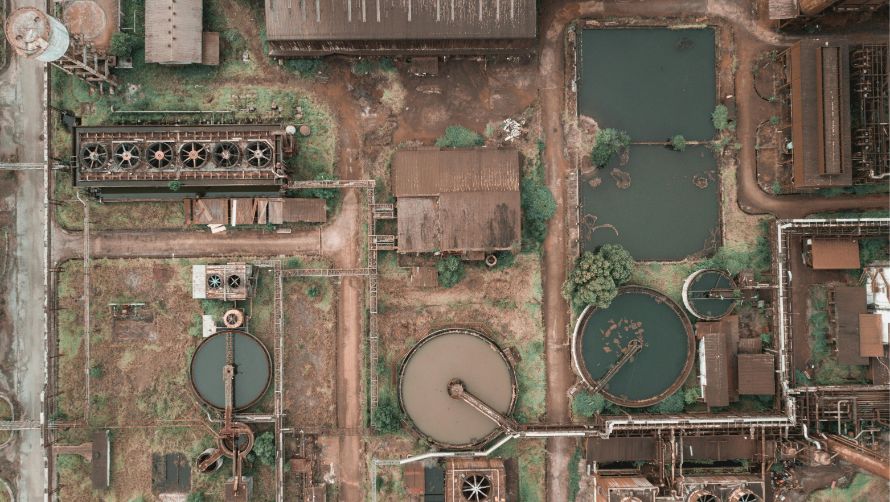The Effluent Treatment Plant (ETP) is an essential system across industries, designed to treat wastewater generated from manufacturing, chemical processes, cooling systems, and cleaning operations. Industrial effluents often contain suspended solids, oils, organic matter, heavy metals, acids, alkalis, and chemical residues that must be treated before discharge or reuse.
ETP units typically use a combination of physical (screening, sedimentation), chemical (neutralization, coagulation), and biological (aerobic and anaerobic treatment) methods to reduce pollutants and comply with environmental regulations.
During treatment, hazardous gases like ammonia (NH3), hydrogen sulfide (H2S), and methane (CH4) can be released from aeration basin, anaerobic digesters, and sludge handling areas. In some facilities, chlorine (Cl2) may also pose a leak risk in disinfection units.
To ensure safety, fixed gas detectors are installed near tanks, digesters, and chemical dosing points, while portable multi-gas detectors are used by workers during inspections, confined space entries, and maintenance.
This combination of monitoring ensures worker protection, environmental compliance, and operational safety across industries.

An Effluent Treatment Plant (ETP) is a critical system in most industries for treating wastewater before discharge or reuse. Industrial wastewater often contains suspended solids, oils, toxic chemicals, heavy metals, acids, alkalis, and organic contaminants. The ETP uses a combination of physical (screening, sedimentation), chemical (coagulation, pH neutralization), and biological (aerobic and anaerobic treatment) processes to reduce pollutants. Treated water is discharged safely to the environment or recycled for industrial operations, minimizing environmental impact and conserving water resources.
Types of Gases Present
Ammonia (NH3): Released from effluent treatment stages where nitrogen compounds are present in the wastewater.
Hydrogen Sulfide (H2S) : Generated from the anaerobic digestion of organic material in wastewater or when sulfur-containing waste is present.
Nitric Oxides (NOx) : Produced during combustion processes used in the treatment or disposal of effluent.
Sulfur Dioxide (SO2) : Released during the neutralization of sulfur-containing wastewater or during chemical dosing.
Carbon Dioxide (CO2) : Released from biological treatment processes or neutralization steps
Volatile Organic Compounds (VOCs) : Emitted from various stages of treatment, including chemical addition or biological treatment units.
Chlorine (Cl2) : Used in some disinfection processes, with the potential for leakage if not properly controlled.
Methane (CH4) : Can be released during the anaerobic treatment of organic waste or from wastewater storage tanks
Chemical Dosing Systems
Chemical dosing systems are used to add neutralizing agents, coagulants, or flocculants into the wastewater treatment process. Leaks may occur from pump seals, injection points, or supply lines.
Fixed Point Detectors: Install NH₃, H₂S, and VOC detectors at dosing stations, chemical storage tanks, and injection points.
Portable Detectors: Used during routine maintenance, chemical tank inspections, and to monitor for leaks around pump seals and injection ports.
Biological Treatment Units
Biological treatment units, such as activated sludge systems, use microorganisms to break down organic matter in the wastewater. Gases like methane and hydrogen sulfide can be generated during anaerobic digestion
Fixed Point Detectors: Install CH₄, H₂S, and VOC detectors near biological reactors, digesters, and aeration tanks.
Portable Detectors: : Used for inspecting anaerobic digester tanks, checking gas collection points, and monitoring for fugitive emissions during maintenance.
Aeration Systems
Aeration systems are used to supply oxygen to biological treatment units. Air leaks or failures in compressors can lead to pressure buildup and potential gas leaks.
Fixed Point Detectors: Install CO₂ and VOC detectors around aeration tanks, compressors, and air supply systems.
Portable Detectors: Used for inspecting aeration blowers, checking gas leaks at connection points, and during air flow system maintenance.
Sludge Handling and Dewatering Units
Sludge handling involves removing solid waste from the effluent, followed by dewatering to reduce its volume. Gas emissions like methane or ammonia can occur from sludge storage tanks or during the dewatering process.
Fixed Point Detectors: Install CH₄, NH₃, and VOC detectors at sludge storage tanks, dewatering machines, and filtration units.
Portable Detectors: Used during routine sludge tank maintenance, dewatering inspections, and to monitor fugitive emissions from storage areas.
Effluent Holding Tanks
Effluent holding tanks are used to temporarily store wastewater before further treatment or disposal. Gases like hydrogen sulfide (H₂S) or methane (CH₄) may build up in poorly ventilated tanks.
Fixed Point Detectors: Install H₂S and CH₄ detectors near tank vents, manholes, and discharge points.
Portable Detectors: Used during routine inspections, tank cleaning, and to monitor gas concentrations in confined spaces.
Flotation and Filtration Units
In some treatment plants, flotation or filtration units are used to remove suspended solids or oil from wastewater. Chemical dosing or air injection can create leaks or emissions, especially in high-pressure filtration systems
Fixed Point Detectors: Install VOC, NH₃, and CO₂ detectors near flotation tanks, filter press units, and chemical feed systems
Portable Detectors: Used for inspecting filtration systems, chemical injection points, and checking for leaks during routine maintenance or system upgrades
Effluent Discharge Systems
Treated effluent is typically discharged to the environment via pipelines, ponds, or other outlets. Leaks may occur from discharge pipes or at the outfall, particularly if the effluent contains hazardous gases.
Fixed Point Detectors: Install NH₃, VOC, and SO₂ detectors near discharge pipes, effluent outfalls, and associated storage tanks.
Portable Detectors: Used to inspect discharge points, monitor for gas emissions in open air systems, and ensure that the effluent discharge is within regulated limits.
Chlorination & Disinfection Systems
Chlorine is used in some plants to disinfect wastewater or to neutralize contaminants. Leaks can occur in the chlorine gas cylinders, piping, or the chlorination system.
Fixed Point Detectors: Install chlorine detectors near chlorine gas cylinders, chlorination chambers, and associated piping systems.
Portable Detectors: Used during routine checks of chlorine tanks, piping systems, and during maintenance of disinfection equipment.
